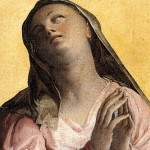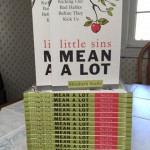Deacon Greg says the Shroud of Turin will be exhibited next year.
Reminds me of a piece I wrote during last years Online Retreat, which you can find here, or in the right-hand sidebar (remember, the earliest posts of the retreat are toward the bottom, and the last at the top).
Poof!
The Shroud of Turin is a most interesting artifact. Whether or not it is indeed the burial cloth of Jesus of Nazareth is perhaps unprovable at this time. There is a lot of conjecture out there, and a great deal of theory. People without access to so much as a fiber from the remarkable cloth have nevertheless formulated ideas on what might have caused the image, which is more readily viewed in a photo negative than with the naked eye. I recall my high school science teacher, who was officially agnostic on the issue but still intrigued, suggesting that the highly detailed image of a brutal scourging and crucifixion “could have been made in a moment of radiation; maybe the instant Jesus came back to life, there was that burst of energy – ‘Poof!’ – and the energy left that imprint!”
This was back in the day, you understand, when teachers and students could talk in free-wheeling fashion – in the closing minutes of class – about things like religion or politics without tempting lawsuits.
For some, the question of the imprint’s origin is of enormous scientific import, for others, it matters that the shroud be proved Jesus’ burial cloth because their faith wants it to be so. And some desperately want the thing to be disproved, and shown a hoax, because their lack of faith demands it.
Mother Angelica tells a great story in one of her books; a visitor to her in the monastery brought a tag-along friend. As their time together drew to a close, Angelica offered both women a set of her little inspirational books. The “tag-along” refused them. “If I read them, I might have to change, and I don’t want to,” the woman said to her.
I had a similar email, once, wherein a writer confessed an attraction to Christianity that was resolutely fought against because “I don’t want to live my life differently, and if I became a Christian, I would have to.”
I don’t remember Mother Angelica’s response to the tag-along’s refusal, but I remember mine. “Oh, dear,” I wrote back, “I honor your strong ethical feeling about it, but if all of us who loved Christ managed to live perfectly saintly lives, what would we need of Him?”
It was a snarky remark meant to lighten the discourse and also try to put the correspondent at ease, but there was some truth in it. Christ came, he said, because “the sick need a physician.” And as the saying goes, church communities are “not museums of saints but hospitals for the sick.”
I know some people have a conversion experience and it is a single miraculous moment that literally transforms them – “Poof!” President Bush said Jesus “changed my heart” and made him a different person. I believe those stories, too, when they’re told. As I wrote a while back:
Some would argue that the experience of conversion is one-part emotional breakdown and one part synapse-misfirings, not dissimilar to an unusual drug experience. That would be more convincing if people who’d tripped exceedingly well – or badly – then found their lives, their perceptions, their conscience, their attitudes and their desires to be instantly and immediately and permanently changed. But usually a drug experience does not result in such a radical shift.
Conversion is a life long process. One does not drink the Milk and Honey only once in life. Indeed, we humans are easily distracted and often need to be taken by the arm and steered back like recalcitrant children. But speaking only for myself, that first experience of Christ changed me enough so that each new experience, each new Milk and Honey moment – whether drunk in a garden or a desert – simple deepened my knowledge and appreciation; it renewed. It brought further surrender and thus further intimacy. “
There are people who have spent years of their lives trying to prove or disprove the authenticity of the Shroud of Turin, and I expect they will be replaced by others, and the debate will rage on for decades or even centuries – because even if science could prove either question beyond a shadow of a doubt – people will still believe what they want, or need, to believe.
Without being dismissive, then, we must consider that the Shroud – while fascinating – is a picture of Christ, but not a reflection of Him. For reflections, we have to look elsewhere; we have to look to each other.
“You may be the only Christ your neighbor ever sees!”
— Mother Angelica
That’s obvious, and yet we forget it all the time. We forget that sometimes we see Christ – the loving and gentle Christ – in the story of a son gently helping his father through his last years, or we see him in a teenager laughing with his friends while pondering mystery, and we see him again in the people who cannot do enough to help, and sometimes it is the face of the brother who thirsts.
All reflections of Christ, all Christ to each other. And when we stop to notice it, we see Jesus in that instant – “Poof!” – and it changes us. Each time, it changes us, heightens our awareness, so that we can more easily find Jesus, reflected in others, again and again.
By the way, the Shroud of Turin will be put on display again in 2010. For what it is worth, I believe it is the burial cloth of Christ. It would be so great if it were, wouldn’t it? But, my faith would not be shaken if it were not the authentic cloth.
We don’t need it to recognize Christ, after all.
All Retreat Presentations are linked here.











